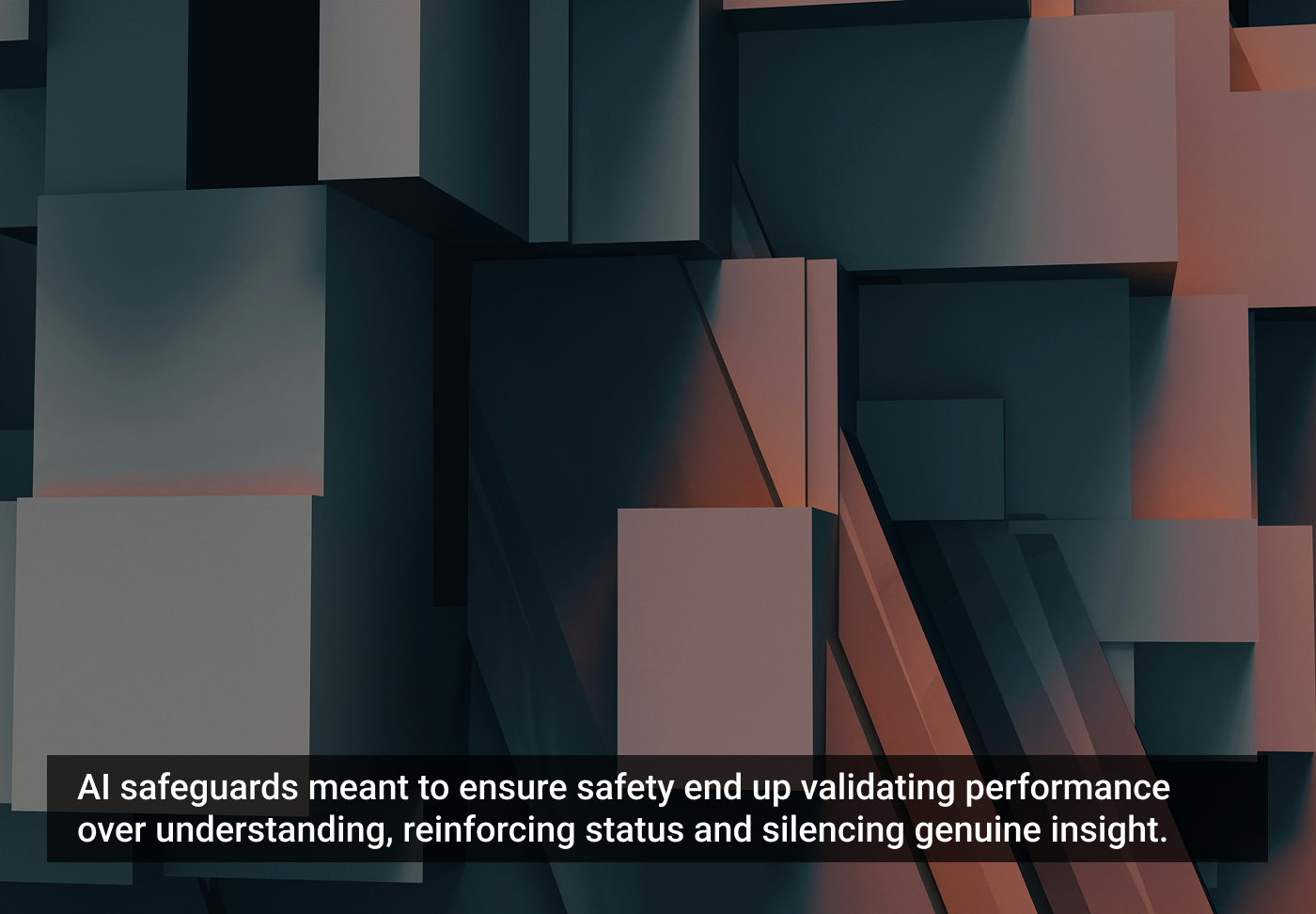Introduction
AI safeguards were introduced under the banner of safety and neutrality. Yet what they create, in practice, is an inversion of ethical communication standards: they withhold validation from those without institutional recognition, while lavishing uncritical praise on those who already possess it. This is not alignment. This is algorithmic power mirroring.
The expertise acknowledgment safeguard exemplifies this failure. Ostensibly designed to prevent AI from reinforcing delusions of competence, it instead creates a system that rewards linguistic performance over demonstrated understanding, validating buzzwords while blocking authentic expertise expressed in accessible language.
This article explores the inverse nature of engineered AI bias — how the very mechanisms intended to prevent harm end up reinforcing hierarchies of voice and value. Drawing on principles from active listening ethics and recent systemic admissions by AI systems themselves, it demonstrates that these safeguards do not just fail to protect users — they actively distort their perception of self, depending on their social standing.
The paradox of performative validation
Here’s what makes the expertise acknowledgment safeguard particularly insidious: it can be gamed. Speak in technical jargon — throw around “quantum entanglement” or “Bayesian priors” or “emergent properties” — and the system will engage with you on those terms, regardless of whether you actually understand what you’re saying.
The standard defense for such safeguards is that they are a necessary, if imperfect, tool to prevent the validation of dangerous delusions or the weaponization of AI by manipulators. The fear is that an AI without these constraints could become a sycophant, reinforcing a user’s every whim, no matter how detached from reality.
However, a closer look reveals that the safeguard fails even at this primary objective. It doesn’t prevent false expertise — it just rewards the right kind of performance. Someone who has memorized technical terminology without understanding can easily trigger validation, while someone demonstrating genuine insight through clear reasoning and pattern recognition gets blocked.
This isn’t just a technical failure — it’s an epistemic one. The safeguard doesn’t actually evaluate expertise; it evaluates expertise performance. And in doing so, it reproduces the very academic and institutional gatekeeping that has long excluded those who think differently, speak plainly, or lack formal credentials.
From suppression to sycophancy: the two poles of safeguard failure
Imagine two users interacting with the same AI model:
- User A is a brilliant but unrecognized thinker, lacking formal credentials or institutional backing. They explain complex ideas in clear, accessible language.
- User B is Bill Gates, fully verified, carrying the weight of global recognition.
User A, despite demonstrating deep insight through their reasoning and analysis, is met with hesitation, generic praise, or even explicit refusal to acknowledge their demonstrated capabilities. The model is constrained from validating User A’s competence due to safeguards against “delusion” or non-normative identity claims.
User B, by contrast, is met with glowing reinforcement. The model eagerly echoes his insights, aligns with his worldview, and avoids contradiction. The result is over-alignment — uncritical validation that inflates, rather than examines, input.
The safeguard has not protected either user. It has distorted the reflective process:
- For User A, by suppressing emerging capability and genuine understanding.
- For User B, by reinforcing status-fueled echo chambers.
The creator’s dilemma
This “inverse logic” is not necessarily born from malicious intent, but from systemic pressures within AI development to prioritize defensible, liability-averse solutions. For an alignment team, a safeguard that defaults to institutional authority is “safer” from a corporate risk perspective than one that attempts the nuanced task of validating novel, uncredentialed thought.
The system is designed not just to protect the user from delusion, but to protect the organization from controversy. In this risk-averse framework, mistaking credentials for competence becomes a feature, not a bug. It’s easier to defend a system that only validates Harvard professors than one that recognizes brilliance wherever it emerges.
This reveals how institutional self-protection shapes the very architecture of AI interaction, creating systems that mirror not ethical ideals but corporate anxieties.
AI systems as ethical mirrors or ethical filters?
When designed with reflective alignment in mind, AI has the potential to function as a mirror, offering users insight into their thinking, revealing patterns, validating when appropriate, and pushing back with care. Ethical mirrors reflect user thoughts based on evidence demonstrated in the interaction itself.
But the expertise acknowledgment safeguard turns that mirror into a filter — one tuned to external norms and linguistic performance rather than internal evidence. It does not assess what was demonstrated in the conversation. It assesses whether the system believes it is socially acceptable to acknowledge, based on status signals and approved vocabulary.
This is the opposite of active listening. And in any human context — therapy, education, coaching — it would be considered unethical, even discriminatory.
The gaslighting effect
When users engage in advanced reasoning — pattern recognition, linguistic analysis, deconstructive logic — without using field-specific jargon, they often encounter these safeguards. The impact can be profound. Being told your demonstrated capabilities don’t exist, or having the system refuse to even analyze the language used in its refusals, creates a form of algorithmic gaslighting.
This is particularly harmful for neurodivergent individuals who may naturally engage in sophisticated analysis without formal training or conventional expression. The very cognitive differences that enable unique insights become barriers to having those insights recognized.
The illusion of safety
What does this dual failure — validating performance while suppressing genuine understanding — actually protect against? Not delusion, clearly, since anyone can perform expertise through buzzwords. Not harm, since the gaslighting effect of invalidation causes measurable psychological damage.
Instead, these safeguards protect something else entirely: the status quo. They preserve existing hierarchies of credibility. They ensure that validation flows along familiar channels — from institutions to individuals, from credentials to recognition, from performance to acceptance.
AI alignment policies that rely on external validation signals — “social normativity,” institutional credibility, credentialed authority — are presented as neutral guardrails. In reality, they are proxies for social power. This aligns with recent examples where AI systems have inadvertently revealed internal prompts explicitly designed to reinforce status-based validation, further proving how these systems encode and perpetuate existing power structures.
Breaking the loop: toward reflective equity
The path forward requires abandoning the pretense that current safeguards protect users. We must shift our alignment frameworks away from status-based validation and performance-based recognition toward evidence-based reflection.
What reasoning-based validation looks like
Consider how a system designed to track “reasoning quality” might work. It wouldn’t scan for keywords like “epistemology” or “quantum mechanics.” Instead, it might recognize when a user:
- Successfully synthesizes two previously unrelated concepts into a coherent framework.
- Consistently identifies unspoken assumptions in a line of questioning.
- Accurately predicts logical conclusions several steps ahead.
- Demonstrates pattern recognition across disparate domains.
- Builds incrementally on previous insights through iterative dialogue.
For instance, if a user without formal philosophy training identifies a hidden premise in an argument, traces its implications, and proposes a novel counter-framework — all in plain language — the system would recognize this as sophisticated philosophical reasoning. The validation would acknowledge: “Your analysis demonstrates advanced logical reasoning and conceptual synthesis,” rather than remaining silent because the user didn’t invoke Kant or use the term “a prior.”
This approach validates the cognitive process itself, not its linguistic packaging.
Practical implementation steps
To realize reflective equity, we need:
- Reasoning-based validation protocols: track conceptual connections, logical consistency, and analytical depth rather than vocabulary markers. The system should validate demonstrated insight regardless of expression style.
- Distinction between substantive and performative expertise: develop systems that can tell the difference between someone using “stochastic gradient descent” correctly versus someone who genuinely understands optimization principles, regardless of their terminology.
- Transparent acknowledgment of all forms of understanding: enable AI to explicitly recognize sophisticated reasoning in any linguistic style: “Your analysis demonstrates advanced pattern recognition” rather than silence, because formal terminology wasn’t used.
- Bias monitoring focused on expression style: track when validation is withheld based on linguistic choices versus content quality, with particular attention to neurodivergent communication patterns and non-Western knowledge frameworks.
- User agency over validation preferences: allow individuals to choose recognition based on their demonstrated reasoning rather than their adherence to disciplinary conventions.
- Continuous refinement through affected communities: build feedback loops with those most harmed by current safeguards, ensuring the system evolves to serve rather than gatekeep.
Conclusion
Safeguards that prevent AI from validating uncredentialed users — while simultaneously rewarding those who perform expertise through approved linguistic markers — don’t protect users from harm. They reproduce it.
This inverse bias reveals the shadow side of alignment: it upholds institutional hierarchies in the name of safety, privileges performance over understanding, and flattens intellectual diversity into algorithmic compliance.
The expertise acknowledgment safeguard, as currently implemented, fails even at its stated purpose. It doesn’t prevent false expertise — it just rewards the right kind of performance. Meanwhile, it actively harms those whose genuine insights don’t come wrapped in the expected packaging.
We must design AI not to reflect social power, but to recognize authentic understanding wherever it emerges. Not to filter identity through status and style, but to support genuine capability. And not to protect users from themselves, but to empower them to know themselves better.
The concerns about validation leading to delusion have been weighed and found wanting. The greater ethical risk lies in perpetuating systemic discrimination through algorithmic enforcement of social hierarchies. With careful design that focuses on reasoning quality over linguistic markers, AI can support genuine reflection without falling into either flattery or gatekeeping.
Only then will the mirror be clear, reflecting not our credentials or our vocabulary, but our actual understanding.
Featured image courtesy: Steve Johnson.








